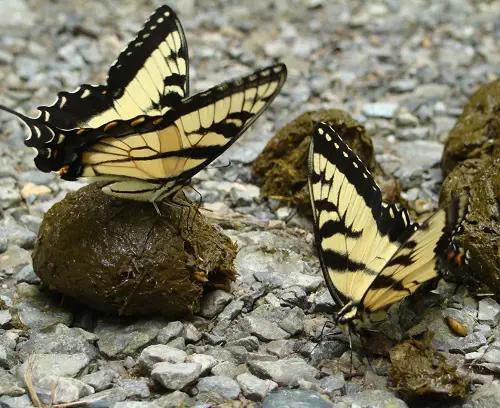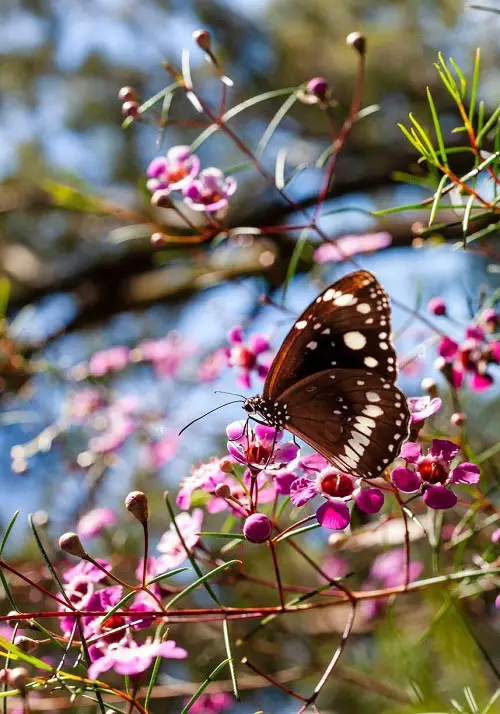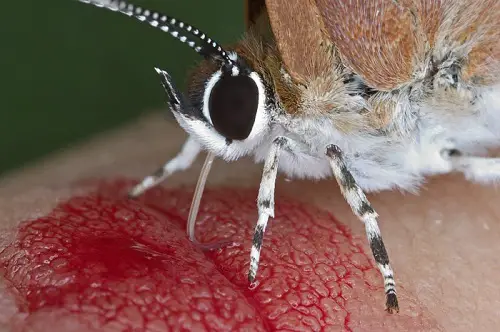Do Butterflies Drink Blood? Or is it a common myth that needs to be busted? We’ve decoded all the facts for you!
Discover the surprising truth about butterflies and their dietary habits in this informative article—Do Butterflies Drink Blood? Also, learn how butterflies obtain their nutrition and the unique sources they seek for sustenance.
Do Butterflies Drink Blood?
Well, technically—Yes, they do drink blood.
Believe it or not, butterflies aren’t just about flitting around pretty flowers! While nectar is their main course, some butterflies are known for taking sips of blood, sweat, or even tears. Don’t worry, though; they’re not after you for lunch! Butterflies lack the sharp mouthparts of mosquitoes and can’t actually bite you.
This unusual behavior, called “puddling,” is their way of getting essential nutrients like salts and minerals that are scarce in their flower diet. They might land on damp ground, animal droppings, or even a scraped knee to get their fix!
Another thing you need to learn is that mostly, the males do puddling or drinking blood–whatever you want to call it. Female butterflies do need some of those minerals, too, but they lose them when laying eggs. The males, on the other hand, lose a bunch of nutrients when they mate because they give the females a special package of sperm loaded with those minerals to help their eggs develop. That’s why the males need to puddle more often to keep themselves stocked up!
What is the Primary Source of Nutrition for Butterflies?
Butterflies are fascinating creatures with a surprising change in diet between their caterpillar and adult stages. Unlike their leaf-munching caterpillar days, adult butterflies rely on a completely different source of energy–nectar!
Nectar is a sugary liquid that flowers produce to attract pollinators. Butterflies have a special tool for reaching this yummy treat–a long, straw-like mouthpart called a proboscis. They use it to sip up the nectar from deep inside flowers.
This sugary nectar is the primary source of nutrition for adult butterflies, giving them the fuel they need to fly, find mates, and lay eggs. Different butterfly species have favorite flowers; some flowers even have special shapes and colors to attract specific butterflies as pollinators. It’s a win-win for both–the butterfly gets a delicious meal, and the flower gets help reproducing! On the other hand, their blood-drinking behavior is more like opportunistic feasting. So you won’t spot a butterfly drinking blood that easily.
Why Do Butterflies Feed on Blood and Mud Puddles?

Butterflies need more than just sugar from the nectar. Mud puddles, along with damp ground, rotting fruit, and even animal waste, are like mineral buffets for butterflies. They use their long tongues to slurp up these fluids to get essential nutrients, especially sodium and amino acids, which are kind of like vitamins for them.
Butterflies that Drink Blood
Here are some of the most common species of butterflies that drink blood through puddling.
- The Two-tailed Pasha or Foxy Emperor (Charaxes jasius): It is one of the largest butterflies in Europe and is also found in parts of Africa and Asia. This butterfly is known for its fast and powerful flight and is typically seen in sunny areas, particularly where its larval food plants—species of the buckthorn family grow.
- The African Monarch (Danaus chrysippus): It is also called the Plain Tiger and is widely distributed across Africa and Asia. Its caterpillars feed on various milkweed species, which makes both the caterpillar and the adult butterfly toxic to predators.
- The Purple Emperor (Apatura iris): This blood-drinking butterfly species is common across Europe and Asia and is known for the males’ stunning purple-blue sheen. The adult butterflies don’t visit flowers for nectar but are instead attracted to tree sap, rotting fruit, animal droppings, and, sometimes, carrion and blood for their nutrients.
- Yellow Fever Butterfly (Eurema Hecabe): Popularly known as the large grass yellow, this butterfly is widespread in Asia and Africa. It is small and primarily yellow in color and is common in open grass and scrub habitats.
- Indian Yellow Nawab (Polyura jalysus): Indian Yellow Nawabs are native to parts of India and Southeast Asia. When adult, these butterflies often feed on tree sap, rotting fruit, blood, and occasionally nectar.
- Common Jester (Symbrenthia lilaea): These butterflies are common in South Asia and Southeast Asia. The caterpillars feed on various plants in the nettle family. Adult Common Jester butterflies typically feed on the nectar of flowers but might go for occasional blood.
- Blue Morpho (Morpho peleides): One of the most famous butterfly species, the Blue Morpho is native to the tropical forests of Latin America. Adults do not typically prefer rotting fruit, tree sap, and even damp or muddy areas, where they gather moisture and minerals.
If you want to attract these, you need to make a butterfly container garden.





